
 |
Tea Clipper |
 |
| from TeaAntiques.com | ||
| Edition Seventy Four |
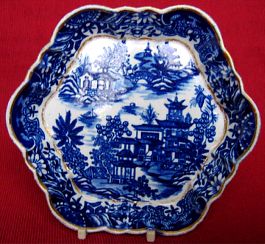
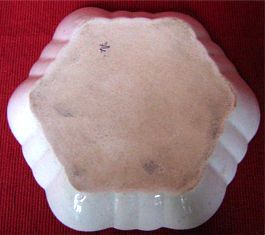
A very attractive Eighteenth century Worcester teapot stand, printed with a delightful blue oriental scene of pagodas in a charming landscape with houses trees, boat and a bridge with two figures crossing it. It also features a bandstand-like structure at the bottom of the design from which the pattern has been given the name the 'bandstand' pattern. This beautiful teapot stand, embellished with gilt decoration, was made at the famous Worcester factory, c1780 and is marked on the reverse side with a disguised numeral mark of a '2'.
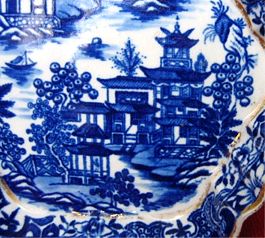
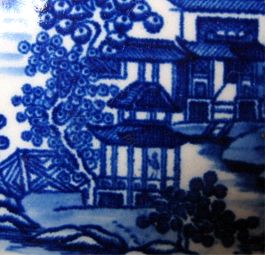
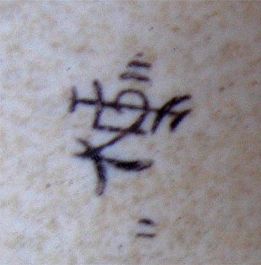
This is a very fine early Worcester teapot stand for the collector of Eighteenth century Worcester or early English porcelain.
More details of this item and other tea related antiques can be found by visiting my web site at www.TeaAntiques.com.
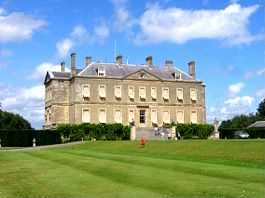 To
bring some colour and cheer to January, I would like to take you on a tour of a
delightful garden, Buscot Park, near Faringdon, Oxon. I looked around the
house and garden last summer and enjoyed the garden in particular.
To
bring some colour and cheer to January, I would like to take you on a tour of a
delightful garden, Buscot Park, near Faringdon, Oxon. I looked around the
house and garden last summer and enjoyed the garden in particular.
Buscot Park is a beautiful late Georgian stone house, built between 1780 and 1783 by Edward Loveden Townsend. The estate was sold on a rich Australian tycoon, Robert Tertius Campbell in 1887 and then again in 1889 to an extremely successful city financier, Alexander Henderson. He was later created 1st Lord Faringdon The house subsequently passed to his grandson, Gavin Henderson, 2nd Lord Faringdon as his own son had died before him. Gavin Henderson remained a bachelor and so the title went to his nephew, Charles Michael, 3rd and current Lord Faringdon.
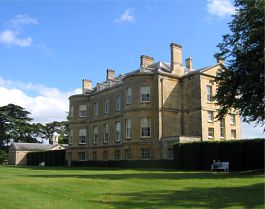 In
1948, Ernest Cook bought the estate and then leased the house and garden back to
Lord Faringdon. Then in the following year, Cook gave the house and gardens to the
Nation Trust. Today the house and estate are very much the responsibility of the
3rd Lord Faringdon, his wife and family rather than the National Trust. Therefore,
they are still adding to their art and antiques collections, adding their mark to
projects within the grounds and the running of the teashop, etc. Certainly in visiting
the house, there is not the usual starchy feel, but the feel of a family home, the
contents of which are a rather eclectic mix of old and contemporary.
In
1948, Ernest Cook bought the estate and then leased the house and garden back to
Lord Faringdon. Then in the following year, Cook gave the house and gardens to the
Nation Trust. Today the house and estate are very much the responsibility of the
3rd Lord Faringdon, his wife and family rather than the National Trust. Therefore,
they are still adding to their art and antiques collections, adding their mark to
projects within the grounds and the running of the teashop, etc. Certainly in visiting
the house, there is not the usual starchy feel, but the feel of a family home, the
contents of which are a rather eclectic mix of old and contemporary.
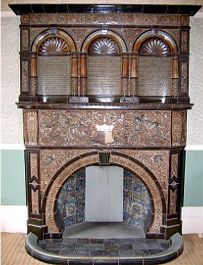 The
house looks much as it did when it was built in the 1780s. There have been alterations
made to the house exterior within its lifetime, but many have since been removed.
This includes the west wing added in the nineteenth century which was demolished
in 1934 by the 2nd Lord Faringdon. In this west wing was the billiard room, the
fireplace made by the Martin Brothers is now housed in the Martinware exhibition
in Pitzhanger Manor Ealing, London. I covered this in the November 2006 edition
of the Tea Clipper.
The
house looks much as it did when it was built in the 1780s. There have been alterations
made to the house exterior within its lifetime, but many have since been removed.
This includes the west wing added in the nineteenth century which was demolished
in 1934 by the 2nd Lord Faringdon. In this west wing was the billiard room, the
fireplace made by the Martin Brothers is now housed in the Martinware exhibition
in Pitzhanger Manor Ealing, London. I covered this in the November 2006 edition
of the Tea Clipper.
There are pavilions flanking each side of the house, these built after the West wing had been demolished. The main house has in its pediment the family crest surrounded by foliate stone carving. It is interesting to see the Regency 'blind boxes' being used with canvas blinds to keep the sun from damaging the content of the house interior. It is rare to see these in operation these days. The other side of the house, the North front is in no need of such blinds and has a handsome pair of bays at either end of the house.
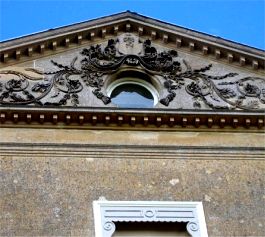
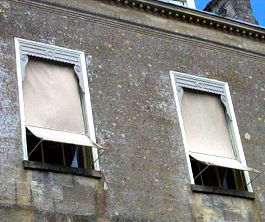
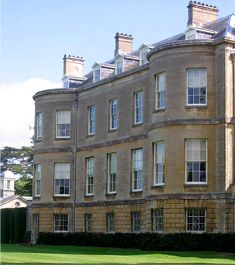
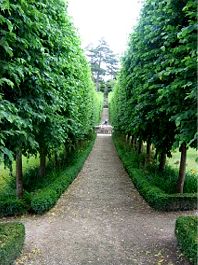
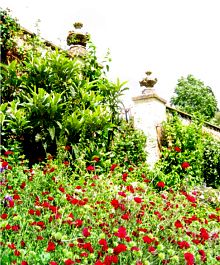 The
house is built on high ground, affording extensive views. To the South West are
the walled gardens. These are set on the side of a deep valley. The present Lord
Faringdon has re-created the gardens in this area. The old walled vegetable garden
is of an unusual walled hexagon shape. He has skilfully planted this out with beautiful
herbaceous borders, with a cross path to the central pool and fountain. The cross
paths have arched walks. the arches covered in trained 'judas trees'. This
walled garden is known as the four seasons garden as it has been planted to have
colour throughout the seasons. It is an interesting mix of planting, that not only
of flowers, but interspersed with fruit and vegetables, including onions, runner
beans, chards etc. The walls of the garden have trained up them fruit trees including
pears, peaches and apples. The borders are lined with clipped box hedging.
The
house is built on high ground, affording extensive views. To the South West are
the walled gardens. These are set on the side of a deep valley. The present Lord
Faringdon has re-created the gardens in this area. The old walled vegetable garden
is of an unusual walled hexagon shape. He has skilfully planted this out with beautiful
herbaceous borders, with a cross path to the central pool and fountain. The cross
paths have arched walks. the arches covered in trained 'judas trees'. This
walled garden is known as the four seasons garden as it has been planted to have
colour throughout the seasons. It is an interesting mix of planting, that not only
of flowers, but interspersed with fruit and vegetables, including onions, runner
beans, chards etc. The walls of the garden have trained up them fruit trees including
pears, peaches and apples. The borders are lined with clipped box hedging.
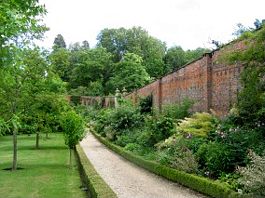
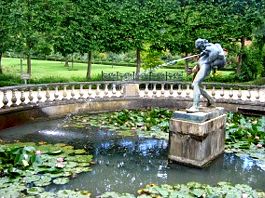
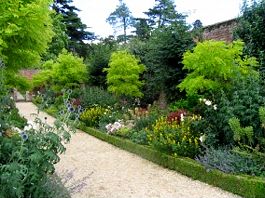
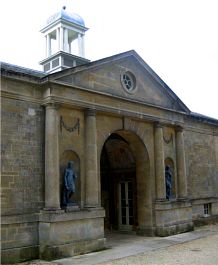
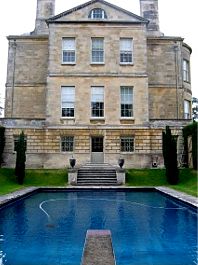 With
the four seasons walled garden being set on one side of a valley, there is a view
across through avenues and steps to the high ground upon which the house stands.
Conversely, standing at the top of the stairway down to the four seasons garden
gives a pleasant bird's eye view of it.
With
the four seasons walled garden being set on one side of a valley, there is a view
across through avenues and steps to the high ground upon which the house stands.
Conversely, standing at the top of the stairway down to the four seasons garden
gives a pleasant bird's eye view of it.
The gardens around the house are quite extensive and will take some time to explore. They are also hilly in places with steps. Starting at the West Pavilion, which contains an active little theatre in one half and a bar in the other, has an arch way through it, the ceiling of which is cleverly painted with murals. These murals were painted by John Hastings at some time during the 1930s and depict the 2nd lord Faringdon with members of his staff. Through the archway of the Pavilion is a view of the family's private swimming pool.
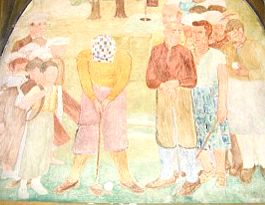
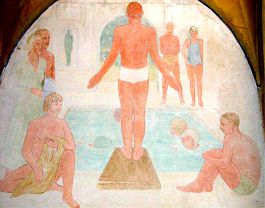
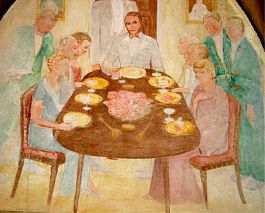
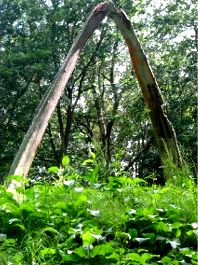 Many
of the garden features are of recent planting and so have many years to become established,
but others are older and are at full maturity. It is, like the house collection,
still evolving with the family. There are wooded areas and tree lined avenues leading
away from the West side of the house into the grounds, each with its own particular
features. The first long drive I walked down away from the house led to a Tumulus
(burial mound) that is capped with a genuine gigantic Wale bone - an unusual feature
to find in a garden! Heading back toward the house and slightly to the right, there
is a vast area of relatively recent tree planting within an open landscape. Passing
through this I discovered the 'Citrus Bowl' , this a circular sunken garden in which
at the centre is a stone Italian well head, with ornate iron work. This is then
surrounded by pot grown citrus trees standing on a gravel base, creating a warm
Mediterranean style garden. Guarding this Citrus Garden at one entrance are a pair
of Egyptian stone gaurdians.
Many
of the garden features are of recent planting and so have many years to become established,
but others are older and are at full maturity. It is, like the house collection,
still evolving with the family. There are wooded areas and tree lined avenues leading
away from the West side of the house into the grounds, each with its own particular
features. The first long drive I walked down away from the house led to a Tumulus
(burial mound) that is capped with a genuine gigantic Wale bone - an unusual feature
to find in a garden! Heading back toward the house and slightly to the right, there
is a vast area of relatively recent tree planting within an open landscape. Passing
through this I discovered the 'Citrus Bowl' , this a circular sunken garden in which
at the centre is a stone Italian well head, with ornate iron work. This is then
surrounded by pot grown citrus trees standing on a gravel base, creating a warm
Mediterranean style garden. Guarding this Citrus Garden at one entrance are a pair
of Egyptian stone gaurdians.
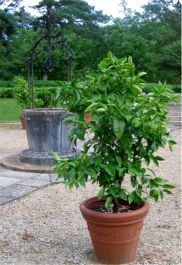
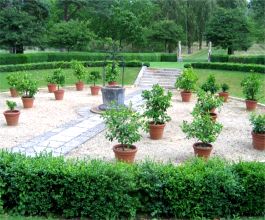
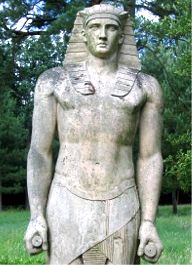
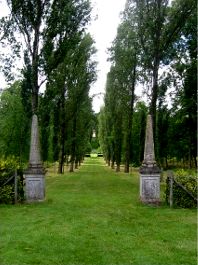
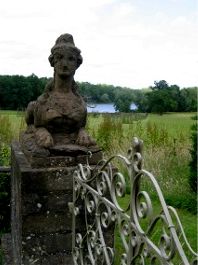 From
the Citrus Bowl it is a good place to notice the crossing straight access paths
and the vistas they form, ended by either a statue, fountain, or some other feature.
Following the long straight path away from the house you eventually get to the Holly
Circle. This circle is planted with variegated Holly as a hedge, but has still some
growing to do to reach maturity. From the holly Circle you can get a view over to
the Big Lake.
From
the Citrus Bowl it is a good place to notice the crossing straight access paths
and the vistas they form, ended by either a statue, fountain, or some other feature.
Following the long straight path away from the house you eventually get to the Holly
Circle. This circle is planted with variegated Holly as a hedge, but has still some
growing to do to reach maturity. From the holly Circle you can get a view over to
the Big Lake.
Turning left down another straight vista to the Marble Vase, this vase contains the ashes of the 2nd Lord Faringdon, so he rests in the peace of his own garden. Turning left at the Marble Vase takes you along to the Swing Garden. Like many of the feature gardens it is based on a roundel shape. This garden is planted around a central sundial in shades of white. This creates a very restful garden and there are four large wooden seat swings which you are cordially invited to sit and relax for while, the perfect spot to rest.
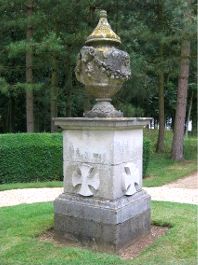
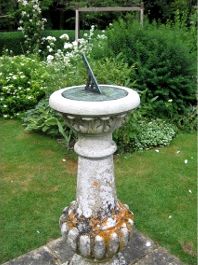
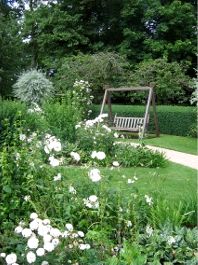
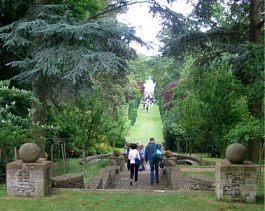 Heading
on along the straight vista takes you back towards the house. Standing on the high
ground you can turn back to see the views down the radiating vistas as they lead
away from the house. To the left is the last of the walks, this leading to the famous
Water Garden, designed by Harold Peto an expert in Italianate design. This garden
was created in 1904 for the 1st Lord Faringdon.
Heading
on along the straight vista takes you back towards the house. Standing on the high
ground you can turn back to see the views down the radiating vistas as they lead
away from the house. To the left is the last of the walks, this leading to the famous
Water Garden, designed by Harold Peto an expert in Italianate design. This garden
was created in 1904 for the 1st Lord Faringdon.
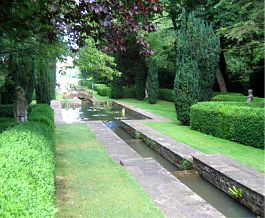 There
was an extension to this Water Garden created in 1911-13. This Water Garden is based
on a long narrow stepped canal that feeds into formal pools planted with lilies.
The first pool that you reach is a circular pool with side recesses, in the centre
of which is a fountain of a boy entwined with a dolphin. Following the canal away
down to the eighteenth century Big Lake you pass a rectangular pool, a hump-backed
balustrade bridge, which links the two sides of the canal. The whole Water Garden
is lined on both sides by formal box hedges in which are positioned Italianate statues
and seats. The final view at the end is across the lake towards the eighteenth century
temple and bridge on the other side. It is certainly an unusual garden and a joy
to see.
There
was an extension to this Water Garden created in 1911-13. This Water Garden is based
on a long narrow stepped canal that feeds into formal pools planted with lilies.
The first pool that you reach is a circular pool with side recesses, in the centre
of which is a fountain of a boy entwined with a dolphin. Following the canal away
down to the eighteenth century Big Lake you pass a rectangular pool, a hump-backed
balustrade bridge, which links the two sides of the canal. The whole Water Garden
is lined on both sides by formal box hedges in which are positioned Italianate statues
and seats. The final view at the end is across the lake towards the eighteenth century
temple and bridge on the other side. It is certainly an unusual garden and a joy
to see.
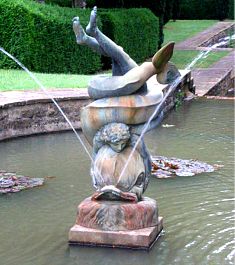
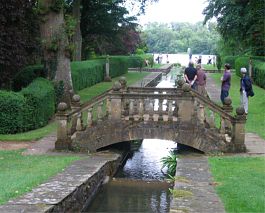
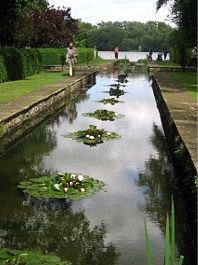
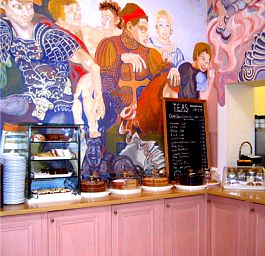
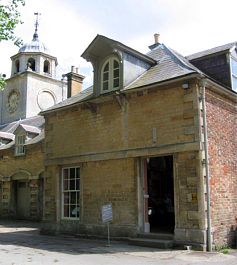 After
my walk round the gardens, I headed back to the walled Garden area, where in one
of the eighteenth century stable buildings there is now the Buscot tearoom. The
room itself is interesting, in that it has been brightly decorated with Frescos,
complementing those at the swimming pool pavilion. The Frescos in the tearoom are
the work of Ellen-Ann Hopkins and painted between 1991-94. They depict amusing scenes
relating to the Faringdon family.
After
my walk round the gardens, I headed back to the walled Garden area, where in one
of the eighteenth century stable buildings there is now the Buscot tearoom. The
room itself is interesting, in that it has been brightly decorated with Frescos,
complementing those at the swimming pool pavilion. The Frescos in the tearoom are
the work of Ellen-Ann Hopkins and painted between 1991-94. They depict amusing scenes
relating to the Faringdon family.
The tearoom serves only teas, drinks and cakes, not lunches. It opens at 2.30, so my advice is to arrive and have tea before doing the gardens, as the gardens stretch far away from the tearoom and will take you several hours to view, including a tour of the house. It is a friendly tearoom that serves home made cakes and scones. I plumped for a slice of Victoria cream and jam sponge cake, which was very good. They had a variety of teas including for me, Lapsang Souchong. As well as the indoor seating, there are some outside tables where you can sit on a fine day.
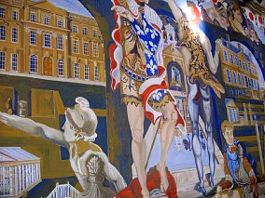
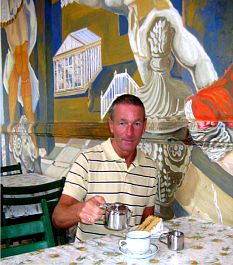
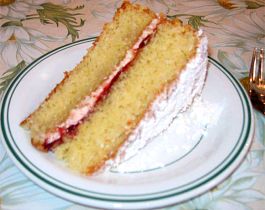
Buscot Park is a beautiful house and garden to visit, one that still remains a family home, where the family continue to add to the art and antique collections and improve upon the gardens. It is very much a living house, one with a heart and soul.
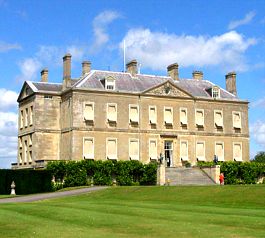
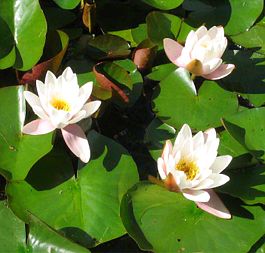
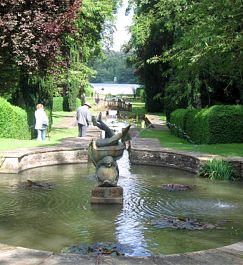
May I take this opportunity
to wish you all a prosperous New Year for 2007
To review past newsletters, just follow this link:
Past newsletters.
To subscribe to this free newsletter -
Click here